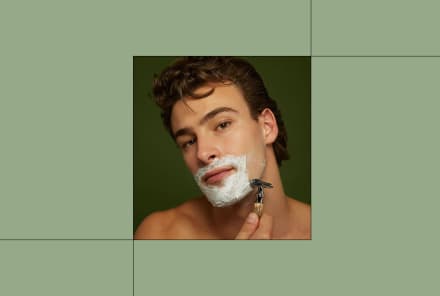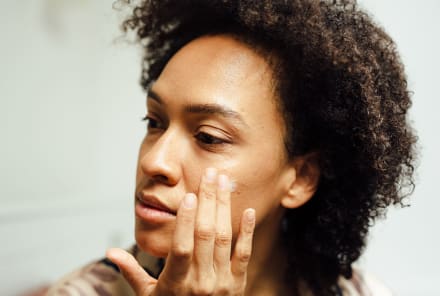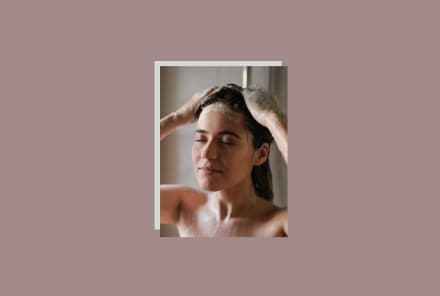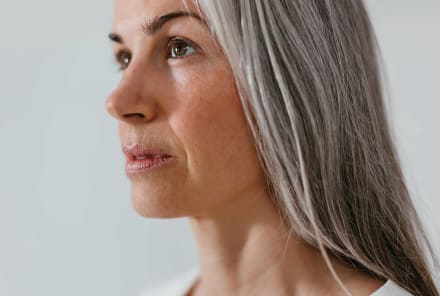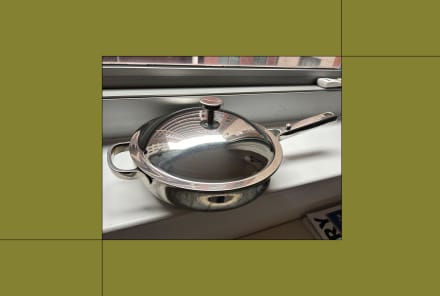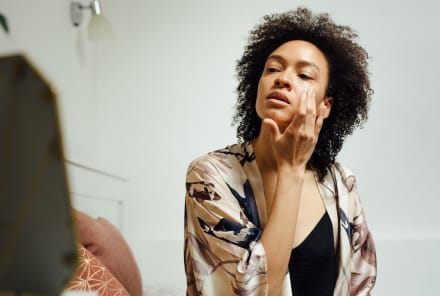Advertisement
The LOC Method: How To Layer Products For Soft, Frizz-Free Curls

Ask anyone in the curl community the secret to soft, bouncy curls, and they'll likely tell you: Moisture, and lots of it. But sometimes your hair is perpetually thirsty no matter how many hydrating hair masks you lather on—leaving it dry, frizzy, and dull.
Enter: the LOC method. A popular term in the curl community that isn't so difficult to add to your post-shower routine (you may even have all the products you need at the ready). If you find your strands practically screaming for moisture, consider this clever three-step technique to lock in the hydration.
What is the LOC method?
The term itself was coined by the natural hair community, a mnemonic device for the order of products you should use post-rinse: That is, liquid (or leave-in), oil, and cream. "For me the LOC method is something you do whenever you're doing a wash-and-go curly style," adds hairstylist Anthony Dickey, founder of Hair Rules.
It's been a popular topic among many natural hair forums, where beauty fans discuss their own natural hair journeys—including what helps keep their curls healthy and hydrated. One of those tried-and-true ways is to condition and seal the hair shaft immediately post-wash. And that's where this layering order comes into play.
Hair type.
As for which hair types can benefit most from the LOC method, it’s especially great for curls that fare well with tons of moisture (typically your type 3’s and 4’s). Curly, coily, and kinky hair types would want to seal the hair shaft immediately post-wash, which is exactly what the LOC method entails.
That's not to say waves and loose curls (types 2a to 2c) can't benefit from the LOC method, too. The LOC method simply refers to a layering technique—so you can sub in any products you please. You'll want to select the right products for your individual hair texture, "especially when it comes to selecting your oil," says Nick Stenson, celebrity hairstylist and artistic director of Matrix. (Our recommendations below!)
If you don’t know your hair type, check out our quick quiz and find the best products for each strand pattern here.
Hair porosity.
Another factor to consider before trying the LOC method is your hair porosity, or how well your hair cuticles absorb and hold on to moisture. (You can test your hair’s porosity with this quiz.)
Generally, the LOC method is best for high porosity hair—meaning, water tends to flow more freely in and out of your strands. Your hair absorbs water and product easily, but it also can evaporate at a quicker rate—that’s why sealing in that water with an occlusive (hello, LOC method!) is sublime.
Folks with low porosity hair, don’t fret: You can use the LOC method, too. You just need a slightly different approach, as your strands have denser cuticles and a harder time absorbing water and product. Specifically, the “liquid” part of the LOC equation becomes even more important: You’ll want to make sure your hair stays wet as you apply your oil and cream—you may even want to use steam (like from the shower) while applying to help open the cuticle and make it easier for the water and moisture to seep in.
Product prep.
Here’s the general line-up:
- Leave-in conditioner.
- Oil.
- Curl cream.
- Spray bottle, in case you need to re-wet sections of hair.
- T-shirt or microfiber towel (in case you want to ring out some water beforehand or plop your curls after).
- Diffuser, if you choose to heat style the curls for more definition.
Now, as we mentioned, you may need a different set of leave-ins, oils, and creams depending on your hair type and porosity. While it's hard to identify a general rule of thumb (everyone's hair is different), heavy product usually weighs down fine hair, while too-light products might not provide dense coils with enough moisture. Here are our recommendations:
- For curls, kinks, and coils: For these hair types prone to dryness, dense oils and creams are key for locking in moisture. Think castor oil, coconut oil, and shea butter to keep water from seeping out, followed by a curl cream (we love this option by Miss Jessie’s) to keep curls springy and soft.
- For waves and loose curls: Lightweight products are your friends, here. Think milks or serums for your leave-in step, then a lighter oil (like jojoba or avocado), followed by a weightless curl-defining cream or mousse.
- High porosity picks: "This type of hair requires super-creamy, nutrient-rich hair care products that seal in moisture,” Branch once told us about high porosity hair. Reach for denser oils, like castor or olive, as well as creamy butters to protect the strands.
- Low porosity picks: "I find that water-based products with butters, lightweight oils, glycerins, and honey work really well to provide moisture and slip in between those cuticles,” says hairstylist Danielle Malary of Lumiere Vive Salon about low porosity hair. You can still opt for those thicker creams and oils—just make sure the products are actually penetrating rather than sitting atop the strands.
Again, it takes some level of guesswork to find your trio of stylers depending on your hair type and porosity combination.
How to do the LOC method:
Curious about how to refine those curls? After hopping out of the shower and detangling, mind the three steps:
- "L" stands for "liquid" or "leave-in." There's some nuance here: Some are partial to using just water, while others use a water-based leave-in conditioner to coat the strands. Whatever you choose, make sure you're applying enough moisture. "You want to lubricate the strands and soften the hair, which helps to rebuild your natural texture," Dickey says. Stenson agrees, even recommending a spray bottle to keep the strands saturated, especially on the porous ends of the hair.
- Second is "O," which stands for "oil." It's meant to seal in all the moisture you've just applied to your hair. So after coating your hair with leave-in, slide a natural oil through your strands.
- Finally, your final layer of product: "C," which stands for "cream." Once your oil seals the hair shaft, apply a styling product to better hold those curls. In terms of which products to reach for, it again depends on your hair type. Do you need a curl cream? A mousse? It may vary based on your individual hair's needs, but for those prone to extra dryness, a thick butter-based cream can make sure all that moisture stays locked in.
After, just let your curls dry in their natural form, and try not to touch your hair (it only creates more frizz!).
How often should you do it?
Again, it depends on hair type. An important note: Every time you do the LOC method, you need to start with wet, detangled hair, says Stenson. Which is important, because where you fall on the texture spectrum will determine how frequently you should wash (or co-wash, which is essentially rinsing and reconditioning your hair without a full shampoo)—and thus, how often you should apply the LOC method.
It makes sense: In order to lock in moisture, you have to, well, add some in the first place. "Water is moisture," Dickey says. So in order for the LOC method to have any lasting benefits, knowing how often to rinse is a key point.
Hairstylist tips.
If you haven’t noticed already, you may have to tweak the LOC method to meet your personal hair needs and goals. Below, we’ve compiled some common ways to switch it up:
- If your hair seems to dry (and frizz) as soon as you step out of the shower—common for high porosity hair—Dickey recommends stashing your oils and creams in the shower with you; that way, you can easily slide them through your hair as soon as you rinse out your conditioner, so your products can seal in as much moisture as possible.
- On the flip-side, if you have a looser curl structure, you may want to dry your hair with a microfiber towel or T-shirt before starting the LOC method. "If you put product on when it's sopping wet, it's just going to be flatter," Dickey says.
- On a similar note, if you find your hair weighed down by too much product, try eliminating one step and see how your strands fare.
- Some folks (namely, those with low-porosity hair) find that applying their water-based curl creams before oil can help better hydrate the hair before sealing it—which transforms the venture into the LCO method.
- After completing the LOC method, you can also opt for protective styles (like braids or a two- or three-strand twist out), which Stenson notes will help you "achieve a style with longer wearability."
The takeaway.
The LOC method is just a clever way to remember how to layer products for a frizz-free, curly style. Again, knowing your hair type is key for success; for some fine-haired folk, layering all those products on sopping wet hair can leave your strands limp and oily. And it's not a hard-and-fast rule for curls and kinks, either: Sometimes you'll have to experiment with the order to find what works best for you. Allow us to reemphasize, the perfect air-dry game is a journey, not a destination.
Watch Next
Enjoy some of our favorite clips from classes
Enjoy some of our favorite clips from classes
What Is Meditation?
Mindfulness/Spirituality | Light Watkins
Box Breathing
Mindfulness/Spirituality | Gwen Dittmar
What Breathwork Can Address
Mindfulness/Spirituality | Gwen Dittmar
The 8 Limbs of Yoga - What is Asana?
Yoga | Caley Alyssa
Two Standing Postures to Open Up Tight Hips
Yoga | Caley Alyssa
How Plants Can Optimize Athletic Performance
Nutrition | Rich Roll
What to Eat Before a Workout
Nutrition | Rich Roll
How Ayurveda Helps Us Navigate Modern Life
Nutrition | Sahara Rose
Messages About Love & Relationships
Love & Relationships | Esther Perel
Love Languages
Love & Relationships | Esther Perel
